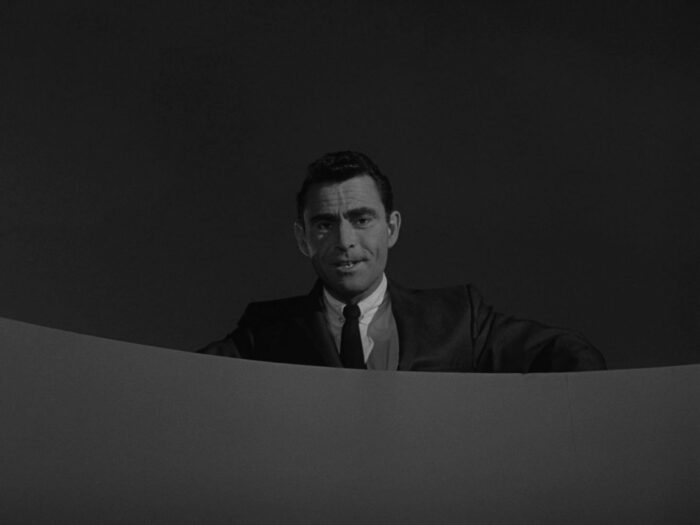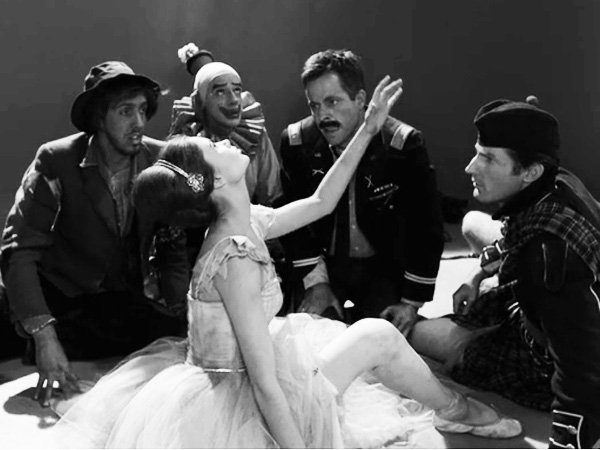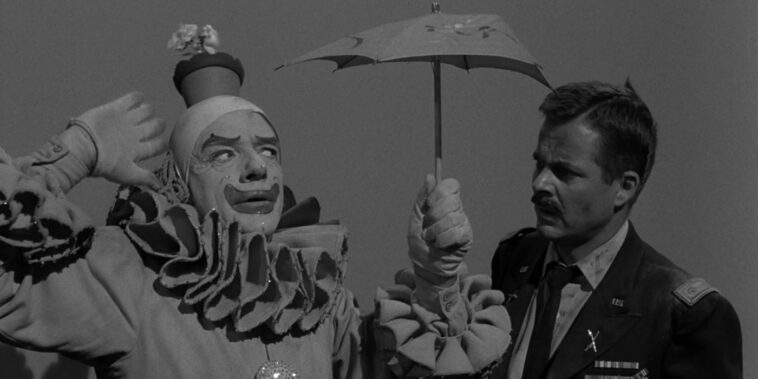The kind of long narrative of serialized TV can be wonderfully immersive, but here at 25YL we also recognize the value of a great standalone episode. Join us as we explore horror and sci-fi anthologies old and new, along with some other standout episodes of shows you love. This week, Will Johnson examines an episode of The Twilight Zone.
It has been a long time since I saw a piece of fiction that, in some way, provided absolutely no clues to how it would conclude. It is truly hard to find anything that remains a mystery in the realm of storytelling. Thanks to millions of years of oral traditions, thousands of years of literature, and a hundred plus years of movie-making and TV, our brains are conditioned to see commonalities and tropes that exist that, based on high percentages and analytics, lead to expected outcomes.
So when I decided to participate in a review of classic episodes of The Twilight Zone, I wanted to find episodes that were not popular or embedded in the cultural zeitgeist, for one, but also episodes where I, upon reading the plot description, would be legitimately wondering where the hell the story was going to go and how it would end.
“Five Characters in Search of an Exit” has a pretty disappointing ending but, like many Twilight Zone episodes, it is more about the journey than the destination. The Twilight Zone has a reputation for providing shocking twists and pull-the-carpet-from-under-you plot reveals, which it has certainly earned. But the show did not solely rely on jaw-dropping endings or genre-defining subversions. Sometimes the show was reflective and symbolic, offering contemplative views on the human condition.
For the most part, “Five Characters” exhibits these qualities in abundance. Since the audience is in the dark as much as the main characters are, all we can do is project our feelings onto them and assume the meaning of the unexplainable. As a result, whether intended or not, “Five Characters” provides us an unending look into humanity’s way of thinking and our role as a community, even when the ending, which provides a very literal explanation, makes all of our assumptions wrong. Sometimes a cigar is just a cigar. But not in the Twilight Zone.

“Five Characters” opens with The Major, a military man in full uniform, waking up in a giant, silver tube. The tube is round and has no imperfections or entrance/exit points. The Major, unaware of who he is or what happened to him, begins to feverishly pound on every surface, trying to find a way out. During his search, he bumps into The Clown, a laughing, song-and-dance type who melodically tells The Major his efforts are in vain.
Once he finally gets his bearings, The Major meets other members in his seemingly doomed scenario: The Hobo, The Bagpiper, and The Ballerina. Just like The Major, they have no idea where they are, what happened to them, or even who they are. Looking at their clothes and accessories, they assume they must be what they look like.
Everyone, with the exception of the eager Major, has been resigned to their fate. The tube is unimpeachable and their lot in life is to simply exist without purpose. The Clown wonders if this is all a dream and if the other four people are figments of the dream. But who is dreaming? The Hobo assumes he is in Purgatory while The Major loudly states that they are all clearly in hell. But one thing is clear: no one has any desire to “leave”, whatever that truly means, at least until The Major arrived.
Despite the convincing fatalism displayed by The Clown, the “captives” eventually warm up to The Major’s desire to escape. The only way to go is up and the only clue that anything exists outside the cylinder is the occasional, earth-shaking sound of a church bell that comes at seemingly random times. So up they go.
Stacked on top of each other, one by one, the characters reach for a presumed precipice. However, with only five of them, they are literally inches short of grasping it. After a random bell sound knocks them all down, The Major decides to try again, this time using a piece of rope from The Clown’s costume, and his own sword to act as a grappling hook.
The Major succeeds in reaching the precipice but falls over the edge, landing in an endless landscape of what looks like snow. The remaining characters, looking up, assume his bravery was foolhardy and pointless, though The Ballerina does hope The Major will return to rescue them.
Cut to a little girl who picks up a doll that looks exactly like The Major out of the snow on a busy New York street. She puts it back in the garbage can that’s being used to collect dolls for a Christmas Salvation Army-like drive. The Donation worker, casually clanging her bell from time to time to bring attention to the drive, thanks the girl for picking the doll up and carries on with her night, hoping more dolls will be delivered.
We return, one last time, to the cylindrical room, where all Five Characters are dolls, seemingly without life and, at this moment, without meaning. Before we go though, the camera spots The Ballerina grabbing The Major’s hand as tears run down her wooden face.

“Five Characters” was clearly a bottle show from conception to delivery. The entirety of the episode takes place, at least until the very last scene, in one cylindrical barren tube and features a dialogue-heavy teleplay (written by Rod Serling) that borders on nihilistic existentialism rather than expected A-to-B-to-C storytelling. Though The Twilight Zone was never unnecessarily cruel, it was straight with its audience: certain behaviors lead to certain outcomes.
While the dolls in ‘Five Characters” don’t have as much control as standard humans do, they are gifted with thought and a form of intellectual free will: they can think for themselves and come to conclusions that define their reality. When we meet The Major, he is stuck with four people who had essentially given up. But it is his dogged determination that springs them into action. Granted, all his troubles lead him nowhere but, just like the Ballerina at the end, we feel for someone trying to overcome severe limitations, even if they fail.
The biggest metaphor I got from the episode was “inside-the-box” thinking (or, “inside the cylinder”, if you will). We, as humans, sometimes work in packs and, for better or worse, we sometimes fear going outside the box/cylinder to challenge our own perceptions. In a way, the four characters of The Clown, The Ballerina, The Bagpiper, and the Hobo represent a sort of tribalism and within that tribe, they exhibit certain traits. The Hobo is kind of along for the ride while the Ballerina is a dreamer, wondering without actually acting. The Clown is all about the status quo and is the most forceful, while The Bagpiper is, well, I haven’t figured out what he is yet. The Major becomes the outsider who tries to rile the tribe up and make them think outside the box, literally and figuratively.
This metaphor breaks down, of course, when you realize the people are actually dolls and, as Serling points out in his closing narration, someday these dolls might have a purpose and might actually be loved but, until then, they wait, prisoners to fate. This literal interpretation defines the characters’ circumstances but, at least until that reveal, you can read into the cylinder’s inhabitants actions as symbolic.
I must confess I hadn’t seen this episode before reviewing it which was kind of the point of this exercise. In the end, I found something engaging, metaphorical, and philosophical, which had me guessing throughout its run time. I highly recommend “Five Characters Searching For An Exit”.
For further Twilight Zone reading, please see my full season, episode by episode breakdown of CBS All-Access’ The Twilight Zone from Jordan Peele.


“no one has any desire to ‘leave’, whatever that truly means, at least until The Major arrived. Despite the convincing fatalism displayed by The Clown, the ‘captives’ eventually warm up to The Major’s desire to escape.”
This reminds me of The Time Machine (1960). The Eloi seem content knowing that they will one day walk into the sphinx and never come back until George convinces them to go down below and find out what’s going on, and eventually fight and destroy the Morlocks.
Bill, I do a series of lectures on the original TZ & Rod Serling so I’m always looking for fresh thinking on the series, Serling and specific episodes. This is definitely a new bit of insight into a very challenging episode.Appreciate it and hope you’ll do more on the original series. BTW…I also enjoy the new Peele series (esp Blurryman) and will be reading your reviews over the next few weeks.
This has always been a favorite of mine, also Obsolete man… Twilight zone was and is aa ge
I saw the episode for the first time in 2012. I kept see sawing with each character. At first I thought they were in ‘purgitory’, that the major had been killed at little big Horn and he was in some type of delerious fever, since he got out.. was totally surprised by the ending! Then I thought, oh great… Toy Story!
We all are looking for something. That something is Divine. The connection for me is God. There has to be more to life than just chance.
One of my favorite episodes. I only saw these as reruns growing up in the 80’s but several left a lasting impression on me. Five Characters in Search of an Exit, Eye of the Beholder, To Serve Man and Time Enough at Last. I’ve enjoyed the entire series but these are the ones that stood out to me and are the episodes I recommend to people that haven’t discovered The Twilight Zone. Rod Serling had a brilliant imagination and was a genius at presentation. If you haven’t seen his Night Gallery series, I highly recommend it also.
E. Tristan Booth: I never thought of the connection to the Time Machine. That is a great point.
@michael Is there anywhere I can see your thoughts on the Twilight Zone? I’m very intrigued to know about your lectures.
I’ll be returning to do all of season 2 of the new Peele series and I plan on doing these original episode features every month until they tell me not to!
@alise Yes! This might be the Toy Story Origins: Woody we never knew about! Woody’s grandpa, perhaps?